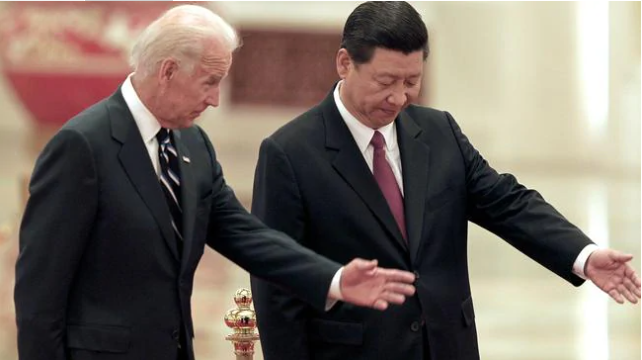
This article is more than
4 year oldChina flexes muscles to US in South China Sea after promising to ‘open fire’

Two formations of missile-carrying bombers and fighters surged into Taiwan’s airspace at the weekend. Their “target”, the USS Theodore Roosevelt and her escort, were captured by satellite as they faced off against the dummy attack run.
Just days after President Joe Biden took up office in the White House, Beijing is ramping up the pressure.
On Friday, it announced its coast guard and warships were authorised to “open fire” on “intruders” within the East and South China Seas.
On Saturday, it sent a “strike package” of powerful bombers within launch range of an approaching US carrier battle group.
On Sunday, a flight of strike fighters followed up with another “dress rehearsal” assault.
Update: #USSTheodoreRoosevelt spotted near #ScarboroughShoal, Jan 25.
— SCS Probing Initiative (@SCS_PI) January 25, 2021
Image credit: @lobsterlarryliu via @planetlabs pic.twitter.com/j2eipcH6oj
The USS Theodore Roosevelt was photographed from space crossing through the narrow strait between Taiwan and the Philippines. Along with her escort of cruisers and destroyers, her mission was to emphasise the freedom of passage applied by international law to the contested waters.
RELATED: ‘Racist’ hypocrites: China’s attack on Oz

ship’s training availability off the coast of Southern California in 2017.
Picture: Paul L. Archer/US Navy/AFPSource:AFP
“Some analysts said the PLA bomber swarm aimed to deter the US carrier and used the warship as a simulated target in an exercise,” the Chinese Communist Party mouthpiece Global Times declares.
STRIKE FORCE
It was a major escalation. But it’s also just another step-change in Beijing’s carefully staged game of creeping brinkmanship.
It’s been ordering bombers and long-range fighters to circle the island democracy of Taiwan for several years. But it has been steadily upping the ante, ordering increasing numbers of anti-submarine patrols and electronic surveillance aircraft to cross into its airspace.
On Saturday, it launched a fully-fledged mock-attack on a US carrier battlegroup.
Thirteen PLA aircraft (Y-8 ASW*1、H-6K*8、J-16*4) entered #Taiwan’s southwest ADIZ on Jan. 23, 2021. Please check our official website for more information: https://t.co/amqJjvHyAj pic.twitter.com/tE1XlHdWmO
— 國防部 Ministry of National Defense, R.O.C. ?? (@MoNDefense) January 23, 2021
The strike force consisted of eight H-6K bombers. They were capable of carrying a total of 48 new YJ-21 “carrier killer” missiles.
Together, these represent Beijing’s strategy to counter Washington’s greatest and most famous military asset – its enormous nuclear-powered aircraft carriers – with swarms of fast, accurate and cheap missiles.

The bombers were protected by a flight of four J-16 long-range fighters as they surged into Taiwan’s airspace over Taiwan’s Pratas atoll, bringing them within firing range of the US fleet.
From that distance, they “can launch a round of saturation attack on a hostile carrier, marking a strong deterrent against US provocations,” CCP analysts told the Global Times.
Fifteen PLA aircraft (Y-8 ASW*2、SU-30*2、J-16*4、J-10*6、Y-8 RECCE*1) entered #Taiwan’s southwest ADIZ on Jan. 24, 2021. Please check our official website for more information: https://t.co/lJ8ddkMvl5 pic.twitter.com/tQV0SoPuWR
— 國防部 Ministry of National Defense, R.O.C. ?? (@MoNDefense) January 24, 2021
On Sunday, a follow-up force probed US defences again. This time two anti-submarine aircraft and a surveillance plane was accompanied by a large force of two Su-30 and six J-10 strike fighters along with four J-16 fighters.
“The aircraft carrier’s deployment to the South China Sea was used as suitable motive for the Chinese military to carry out combat simulations. It allowed them to train and extend their reach,” Taipei-based defence analyst Hung Tzu-chieh told Newsweek.
MIND GAMES

The attack came just days after US President Joe Biden was sworn in.Source:AFP
RELATED: Satellite pics reveal China’s master plan
“The strong should not bully the weak,” Chairman-for-life Xi Jinping told the Davos gathering of billionaires and world leaders on Monday. “Decisions should not be made by simply showing off strong muscles or waving a big fist.”
He’d just ordered the exact opposite.
Things haven’t changed since, either.
Four PLA aircraft (Y-8 ASW, Y-8 EW and J-10) entered #Taiwan’s southwest ADIZ on Jan. 26, 2021. Please check our official website for more information: https://t.co/08UcXIND0F pic.twitter.com/CAy35Xh6U9
— 國防部 Ministry of National Defense, R.O.C. ?? (@MoNDefense) January 26, 2021
Yesterday, Chinese Y-8 anti-submarine and surveillance aircraft were escorted by two J-10 fighters as they once again crossed into the same Pratas atoll airspace.
“The PLA has dispatched mainly Y-8 special mission aircraft for similar missions over the past few months,” the Global Times quotes CCP military analysts as saying. “Sending bombers and fighter jets could be a warning to the US and a simulated practice to boost the PLA’s combat capability against US aircraft carriers.”
It wasn’t just a warning. It was also a demonstration.
“It does demonstrate the PLAAF’s ability to put together a multi-plane strike, which we would likely see in the event of a hot war against Taiwan,” Washington D.C. National War College’s Professor Bernard Cole told US media.
“If Chinese President Xi Jinping pulled the trigger and ordered the PLA to attack Taiwan, the air force certainly would launch more than eight bombers. There are more than 200 H-6s in PLAAF and People’s Liberation Army Navy Air Force service,” adds analyst David Axe.
Satellite via @planetlabs captures more images of #USSTheodoreRoosevelt #OSINT #SouthChinaSea pic.twitter.com/9cHFkmGywT
— liuming (@lobsterlarryliu) January 26, 2021
Meanwhile, Mr Xi has ordered snap live-fire weapons exercises as warships and mobile missile launchers move to impose their presence on the US warships.
“Unlike in 2020 when US aircraft carriers provocatively entered the region, the PLA aircraft carrier Shandong is now standing by in the South China Sea as a stabiliser for the regional situation,” the Global Times boasts.
WAR GAMES
Beijing on Friday authorised its warships and coast guard to open fire on “intruding” vessels in the East and South China Seas, and to destroy any “illegal” structures built on disputed islands.
Now, the US Theodore Roosevelt carrier battle group has been spotted by satellite loitering off Scarborough Shoal, a cluster of reefs hotly contested by both China and the Philippines.
It’s a further challenge to Beijing’s arbitrary assertion of ownership.
New satellite images show USS Theodore Roosevelt aircraft carrier approaching Scarborough Shoal in the South China Sea at a distance of 24 nautical miles before turning back on January 25. Image: @planetlabs
— Duan Dang (@duandang) January 26, 2021
Follow me on Telegram https://t.co/yndMUSaeY3 pic.twitter.com/KpHqVWqcDR
Meanwhile, the guided missile destroyers Shenzen and Wuhan along with the frigate Hengyang conducted the first of several anticipated “combat-oriented drills” at the weekend.
A no-fly zone has been declared across the Gulf of Tonkin between January 27 and 30 as amphibious assault ships Wuzhishan, Changbaishan and Kunlunshan practice beachhead assaults with their troops.
China’s second aircraft carrier, Shandong, is based nearby on Hainan Island.
Meanwhile, a large number of mobile launchers for China’s new advanced intermediate-range ballistic missiles (IRBM) have been deployed within reach of the South China Sea. The Federation of American Scientists say satellite images show the DF-26 launchers taking up positions in the east of Shandong Province.
It is the first time the new weapon has been deployed in such a way.
These missiles have a range of about 5000km and can carry either nuclear or conventional explosives in hypersonic warheads.
“Pictures taken recently by Maxar Technologies’ satellites show a large number of launchers for the DF-26 intermediate-range missile operating at a training site approximately 9 kilometers south of Qingzhou City in Shandong Province”https://t.co/zoKvfDkKGq
— Aadil Brar (@aadilbrar) January 25, 2021
Their purpose is the same as that of the H-6K bomber: to force US aircraft carriers to stay outside their range – which also means keeping out of the East and South China Seas.
The Hong Kong-based South China Morning Post, now subject to Beijing’s strict “national security” laws since the island province was stripped of its autonomy last year, says the DF-26 launchers have been deployed “for intensive training” in response to “continued posturing” by the United States.
Jamie Seidel is a freelance writer | @JamieSeidel




